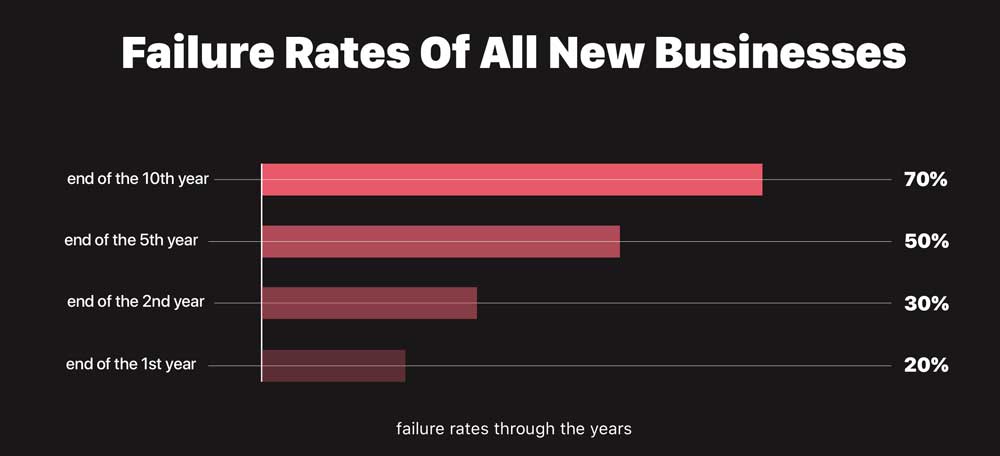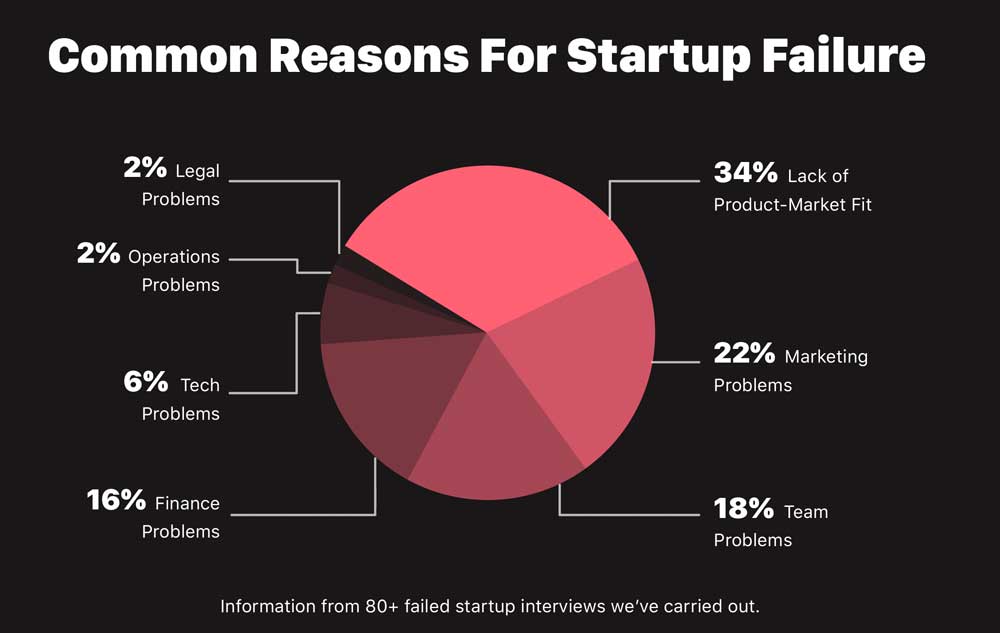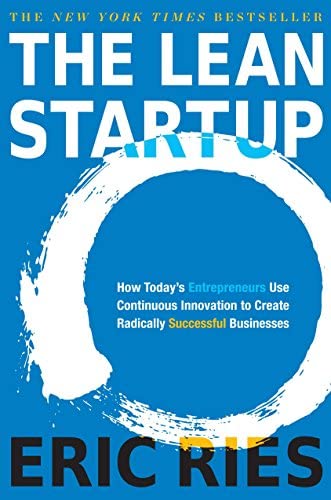Lean Startup Principles, Methodology, and Examples
Everyone who launches a startup is aware of the risks. Failure is something you need to be prepared for; however, it’s always possible to lower your risk of failure and launch a lean startup. Learn how Mobindustry helps clients launch their business software successfully
Introduction
According to Startup Genome, 9 out of 10 startups fail.

Failure can happen over the course of a startup’s lifecycle, with 20% of startups failing in the first year. Then just as a startup is getting older, the probability of failure decreases. Older startups fail when they can’t turn a profit and investors stop pouring money into unprofitable businesses.
According to Failory.com, the most common reason for startup failure is launching a product that doesn’t find its market: 34% of startups end their existence because of this.

Other reasons include marketing issues, problems with the team, and problems with finances.
Finding a perfect market for your product and then making this market aware of your product are the two main goals of any startup. Contrary to popular belief, a product does not have to be perfect to gain traction. And I believe in most cases the traditional startup building strategy doesn’t work anymore. Let’s talk more about this.
Why the traditional startup strategy fails
Twenty years ago, a startup could emerge in a garage, built by Stanford students and launched to the campus. Though it required lots of work that was done with enthusiasm during lots of sleepless nights, it hardly required as much investment and as many resources as startups need now to simply build an MVP.
Over time, competition and technological advancements set the bar so high that it started taking significantly more effort and resources not only to come up with an idea but to bring it to life.
Startup entrepreneurs discovered that the approach of spending lots of time and money on a product that they weren’t sure would be successful was inefficient
Consumers also became pickier. Many features that used to be selling points became standard, so new businesses needed to keep up with everything that had been implemented before.
This meant a new business sometimes needed years just to build their product, and the cost was so high that if the product didn’t succeed after the release, it meant millions of dollars in losses. Soon, startup entrepreneurs discovered that this approach of spending lots of time and money on a product that they weren’t sure would be successful was inefficient. That’s when the lean startup approach emerged and started to gain popularity.
What is a lean startup?
The term “lean startup” refers to using a data-based approach to launching a startup, relying on feedback from potential customers rather than merely on a founder’s ideas. The question “What is lean startup methodology?” is answered by Eric Ries in his 2011 book The Lean Startup. In it, he explores all the methodologies and approaches to launching a lean startup that we’ll discuss in this article, and provides a lean startup definition.
Considering users’ real-life needs and expectations helps a startup optimize resources and spending: basically, you avoid developing what your users don’t actually need. The lean startup methodology is based on experiments and gathering feedback, so it also helps you launch a product fast instead of working on it behind closed doors for years and releasing it after no one needs it anymore (or when they didn’t need it in the first place).

In The Lean Startup, Ries makes a clear distinction between a traditional business that’s established and has stable operations and a startup that’s based on innovation and dynamic changes.
What are some lean startup examples? One of the most famous is Dropbox, which launched a 30-second video that showed how their service would work before launching the product itself. The number of viewers and their comments helped Dropbox estimate the demand for their service and also gain the first users by capturing contact information.
Then, Dropbox analyzed the comments on their video, and the opinions of their target audience helped them to continue the development process and build a product the market needed.
Advantages of a lean approach to startups
Apart from cost-effectiveness, there are lots of other advantages of a lean startup approach:
- Close connection to users
- Low cost of launch
- Fast time to market
- Low marketing and sales costs
- Narrow focus on a target niche
Close communication with potential customers is one of the best traits of the lean approach to building a startup. Unlike the traditional model, where you theorize about the product and present it to your potential customers only after it’s ready, the lean startup model suggests that you first ask, then do.
The low cost of development and launch is another advantage of the lean startup approach, because you develop exactly what your users need instead of getting trapped in dozens of ideas, potential features, and endless iterations. If you develop a product based solely on your idea of what the market demands, you may end up developing lots of unnecessary features.
The time to market shrinks with the lean startup methodology, as you develop a product with a limited number of truly valuable features. Also, if you choose to promote your product before its launch and gather the contact information for your first potential users, you enter the market even before your product is ready.
Low marketing and sales costs. Because your product is already familiar to a small but highly relevant group of people, it will be easier for you to promote it and change it after getting feedback. Marketing and sales costs are higher for established products that entered the market without anyone knowing about them prior to launch.
A narrow focus on a target niche is another advantage of a lean startup. Sometimes, businesses look up to large companies like Google and Amazon. But it’s nearly impossible to compete with them as a new company. The best decision is to choose a narrow target niche and provide an individualized service that will make users choose you.
You may ask, how a lean startup is different from agile and design thinking. The main difference is that you check if your hypothesis is valid before you start the main development process. Both agile and design thinking approaches need to have a product at hand to test it in real-life conditions. The lean startup framework suggests that you can start without it.
Top lean startup methodologies
Now, let’s figure out how lean startups are actually launched. There are three main strategies you can use individually or combine. The market changes, so you should always be ready to change too.
1. MVP (minimum viable product)
The MVP has different meanings in the traditional and lean startup launch methodologies. In traditional startup development, an MVP is a product with only the essential features, thus accelerating the time to market and saving money for future marketing or further development. The main goal of the MVP is to provide a working product to the audience as fast as possible and receive initial feedback. This allows startups to get guidance and know better what to invest in next.
However, many lean startups don’t even bother developing a product at the initial stage: they just create a landing page or a video that demonstrates how a future product will work. Then, they analyze the response and start development.
Sometimes, a startup can release an MVP and then realize they missed the market. In this case, pivoting is another strategy to take.
2. Pivoting
No matter how closely you study the market before the launch or how well you investigate your target audience, your product might miss the market after the release. There can be all kinds of reasons for this, and sometimes changing what your product is about is the best solution.
Sometimes, it takes more than one pivot to find success
When you build your product according to the traditional methodology, pivoting can be quite painful because you have already invested much time, money, and effort into your product. A lean startup allows for much easier pivots.
Sometimes, it takes more than one pivot to find success. One of the main lean startup principles is to not stop experimenting. While pivoting, you can change your product concept, your target audience, the issue your product solves, your marketing strategy, and so on.
3. Cold emailing or calling
Some businesses don’t even bother making an MVP first. Before they even start working on a product, they test their idea by cold emailing or calling potential clients and gauging interest in their concept.
For this strategy, you still need to prepare: study your market, create a business model and have a detailed idea of your future product, and develop a value proposition so you can explain your product to potential clients in your cold emails or calls.
Then, depending on the responses you get, you can decide if there’s demand for your product or service among a particular market and target audience. Make sure to experiment here as well: Cold emailing can show poor results if you just email the wrong people, so it’s important to segment your target audience before experimenting.
5 steps to a lean startup launch
How does a lean startup work? How do you make it work to your benefit? Let’s answer these questions.
1. Build a business model canvas
A business model canvas is an outline of your product. It includes:
- Customer segments
- Value proposition
- Monetization strategies
- Revenue streams
- Resources
- Partners
- Activities
- Marketing channels
- Communication channels
- Budget and cost
At Mobindustry, we help our customers calculate the cost of software development and hardware if it’s a part of the business plan.
At this stage, you can create a vision of your future product and then contact the development companies you’ve shortlisted to ask for quotes. Most software developers will be able to give you approximate cost estimates for your project.
2. Formulate a hypothesis
Lean startups are all about experimenting, so you need to have one or several hypotheses you’ll check. A hypothesis includes three parameters:
Desirability. This part of your hypothesis should answer questions about your users and why they would like to use your product. Assess the attractiveness of your proposal to your chosen target audience.
Viability. Assess whether your potential users will be ready to pay a certain price for your product. Ask yourself whether your business model is viable based on the problem your product solves for your audience.
Feasibility. Now it’s time to do a reality check of your idea. You’ll need to figure out whether you’re able to build and run the business considering your current budget, skills, team, resources, and so on. Maybe at this stage, you’ll find you need to extend your deadline or look for additional funding.
3. Build an MVP
Now it’s time to test the waters. At this point, you don’t need to build a product: just create a prototype or even just a landing page that demonstrates how your product works and solves a problem.
As I already mentioned, there are two types of MVPs in the lean startup method: a landing page and a video. You can also create a presentation or demonstrate your prototype.
At this point, you can also run a cold emailing campaign. This is another way to check if there’s demand for your product, and it’s especially useful for B2B products.
To build an MVP, you need to formulate your product’s core values and present them in any way I already mentioned. You also need to plan how you’ll assess the results of your MVP, e.g. with metrics such as views, comments, responses, and contact details left on your landing page. Set up analytics so you can base your further decisions on hard data.
4. Evaluate the results
After you’ve run your MVP campaign for some time, it’s time to analyze the market response. Your evaluation will depend on the metrics you chose and on what you perceive as a good or bad result.
If you feel like you didn’t get enough responses to your product presentation, this may mean a few things:
- You presented your product to the wrong audience
- Your product doesn’t solve the problem
- Your audience already uses your competitors’ products and doesn’t see a reason to switch to your product
- There’s no demand for your product in this market
- Your product is too broad
- You’re using the wrong platform for your product
The only way to act if you don’t get enough responses is to continue experimenting. At this point, you can pivot. There are several types of pivoting.
1. Zoom-in pivot. If one feature was particularly interesting to your audience, emphasize this feature during your marketing campaign and improve it.
2. Zoom-out pivot. If the main feature didn’ seem to catch your audience’s attention, try to promote another feature and present your product from another angle.
3. Changing the customer segment. If you feel like you’ve just presented your product to the wrong audience, try to show it to another segment of your potential customers and see if it gets more attention.
4. Changing the product’s focus. If your product solves a problem but your target audience doesn’t feel this problem is so important that they’re willing to pay to solve it, you can try to change your product’s focus. Maybe your product can solve another more pressing problem and find demand among potential customers.
5. Changing the platform.
Maybe your product hits the market but it misses the platform. For example, say you created a website when in reality your users want to see the same product on a mobile platform.
How Mobindustry helps to launch lean startups
At Mobindustry, we value a business-oriented approach to building software because we love when people actually use and enjoy the things we build. To help our clients hit the market and eventually profit from their software, we offer certain services:
1. Preliminary estimate
We always provide a preliminary estimate once we hear a client’s ideas. This helps a client build a business plan and predict the costs for building a web or mobile application.
2. Market and competitor research
Most successful businesses have lots of competitors, which means there’s a market for the product or service. We are always ready to help our clients with thorough market research before outlining the project plan. We also provide consulting services, as our team closely watches industry best practices.
3. Building an MVP
As we’re a software development company, our MVPs are usually high-quality software that users can try and provide feedback on. We help our clients extract the most important features and implement them cost-effectively. To lower the costs and time of building an MVP, we offer cross-platform technologies like Flutter that save time without sacrificing quality.
If you want to test the waters, you can start by consulting with our business and technical experts. They will be able to guide you through current market trends and insights, as we’re watching closely to see which businesses are currently thriving.
We can also help you build a simple prototype of your app so you can demonstrate it to investors or potential customers and check if there’s demand for your product or service.


